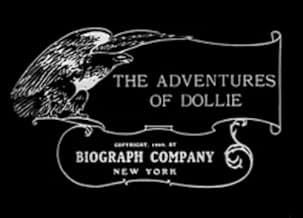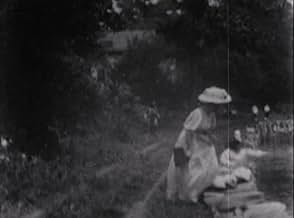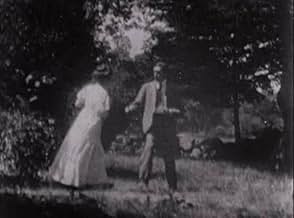Ajouter une intrigue dans votre langueOn a warm and sunny summer's day, a mother and father take their young daughter Dollie on a riverside outing. A gypsy basket peddler happens along, and is angered when the mother refuses to ... Tout lireOn a warm and sunny summer's day, a mother and father take their young daughter Dollie on a riverside outing. A gypsy basket peddler happens along, and is angered when the mother refuses to buy his wares. He attacks mother and daughter but is driven off by the father. Later the g... Tout lireOn a warm and sunny summer's day, a mother and father take their young daughter Dollie on a riverside outing. A gypsy basket peddler happens along, and is angered when the mother refuses to buy his wares. He attacks mother and daughter but is driven off by the father. Later the gypsy sneaks back and kidnaps the girl. A rescue party is organized but the gypsy conceals ... Tout lire
- Directors
- Writer
- Stars
Avis en vedette
In "The Adventures of Dollie", a family of three goes out for a nice trip along the riverside during a sunny summer's day. A gypsy (Charles Inslee) walks by them, and attempts to sell his baskets to the family. The Mother (Linda Arvidson) doesn't want to buy anything from him, and attempts to move on, but this angers the gypsy, who begins to attack the mother and her daughter Dollie (Gladys Egan) until the Father (Arthur V. Johnson) appears and drives the gypsy off. Even more angered, the gypsy decides to kidnap Dollie and hide her inside of a barrel to be able to escape unnoticed. When her parents notice she's been kidnapped, they organize a rescue party, but it's too late: the gypsies have escaped and the barrel where Dollie is hidden is on their wagon. However, this is only the beginning, as the barrel falls from the wagon and falls into the river. Dollie's real adventure is just about to begin.
Written by Stanner E.V. Taylor (his first real work as a scriptwriter), "The Adventures of Dollie" is a very simple tale of action and adventure on a style that was made very popular in that year after the release of J. Searle Dawly's "Rescued from an Eagle's Nest" (the movie where Griffith debuted as an actor), in fact, the plot of both films are so similar that it's clear that this movie was made to cash on Dawly's success (both films are about kidnapped childs). Still, what made this movie a bit different was that this time the focus was on the kidnapped kid instead of the rescuers, as we follow Dollie (or better said, the barrel that contains her) through the film. Some have labeled the movie as racist towards the Romani people (gypsies), but I find such comments out of place as the story simply reflects the ideas of its time, as gypsies weren't seen on a good light because of their nomadic lifestyle.
In this his modest debut as a director, there are already some early touches of Griffith's genius through the movie. While an amateur following the conventions he has learned from his work as an actor (as well as from codirector and future collaborator G.W. Bitzer), Griffith already begins to show his ideas about storytelling in film and his creative use of editing to create emotions on the audience. The effective use he gives to Arthur Marvin's cinematography helps to keep the film dynamic, away from the theatrical style that was common in those years. True, the film is pretty typical and follows an already stablished ideas about film narrative, but credit must to Griffith for making such an accomplished film with almost zero experience behind the camera.
One of Griffith's most famous traits can also be seeing in this movie, and that is his great skill to get natural performances from his actors. As written above, the movie moves away from the stagy style of film-making of the time, and Griffith takes this ideal to his cast too, as he decides to get a more realistic approach in their performances. Arthur V. Johnson and Linda Arvidson (Griffith's wife) are good in their performances, although Johnson tends to overact a bit (understandable as he had little experience on film). Gladys Egan, who plays little Dollie is also very good, although her role is considerably simpler. As the gypsies, Charles Inslee and Madeline West are OK, although like Johnson, they tend to overact a little bit, although that would be natural, since they are playing the common stereotypes of gypsy people.
"The Adventures of Dollie" is not exactly a movie that one would expect from legendary director D.W. Griffith, but then again, most debuts tend to be mere shadows of the future ahead. Later that very same year Griffith would start making some serious experimentation on this very same plot line, and would create some really innovative films in a very short time. Movies like "The Red Man and the Child", "For a Wife's Honor" and "The Lonely Villa" would introduce new and highly inventive ways of storytelling that would further develop film-making as an art. While many of the techniques he used weren't exactly new, he combined them and put them together in a way that later would be considered as the definitive narrative language of cinema. While there are many better Griffith shorts (even from the same year), this movie is a must see if only because it represents the humble start of a master's career. 6/10
The movie was a success, to which Biograph assigned him as its main director. The film itself is quite pedestrian, but it does show Griffith's understanding of that day's cinematic language. A few clipped scenes reflects his desire not to stretch out segments so in vogue in the early 1900's. (Yet the lingering sequence of the barrel traveling downstream shows he hadn't quite grasped future film pacing) Griffith's use of depth-of-field, however reflects a knowledge of departing from stage-bound right-to-left movements and captures the actors moving towards and away from the camera.
There is a public domain version of this film, along with many others by Griffith, available to view over at the Internet Archive. I am going to vote a 9 out of 10 for this one, partly due to it's historical value as the first film by one of the greatest directors of the silent era, and also because I thought it was really great! =)
THE ADVENTURES OF DOLLIE ----- 9/10.
However, Griffith appears to acknowledge one difference between cinema and theatre, one that was to become key to his style ever after, and that is the use of depth. Virtually all the movement in The Adventures of Dollie is towards or away from the camera, as oppose to across it. The long static takes particularly highlight this approach. This is before editing within a scene or using inserts were common methods, and this means we get some odd-looking (and very theatrical) set-ups, as in the scene where Dollie is kidnapped, the father walks away and the gypsy approaches all within the same shot, meaning our sense of logic tells us that the father can't be more than a dozen paces away when his girl is snatched. Griffith is still using the concept of stage wings for entrances and exits, imagining that once someone has walked out of sight they are out of the scene, which looks unnatural for cinema. However, rather than having them at left and right as on a stage, the father exits walking straight into the foreground, while the gypsy emerges from the bushes in the background. It still looks illogical, but it shows a willingness to work on solutions towards a non-theatrical style.
In doing this, Griffith is showing nothing entirely new and certainly nothing exceptional, but he is showing a certain tendency, a particular way of thinking about the medium that would later lead to amazing things. And Griffith also displays his quality as an ideas man that transcends all technique and experience. For example, when the father searches through the gypsy caravan, the gypsy is resting his foot on the barrel in which Dollie is hidden, cockily flaunting the secret before his enemy. It's little touches like this, giving a scene that little bit of character, that separate the great directors from the merely good ones.
Early Works of Film Directors-Review # 8: D. W. Griffith and G. W. Bitzer's The Adventures of Dollie
Le saviez-vous
- AnecdotesDirectorial debut of D.W. Griffith.
- ConnexionsEdited into Spisok korabley (2008)
Meilleurs choix
Détails
Box-office
- Budget
- 1 000 $ US (estimation)
- Durée
- 12m
- Couleur
- Mixage
- Rapport de forme
- 1.33 : 1



















